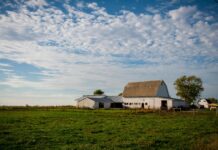JACKSON, Ky. — What would happen if cattle grazed the same pastures with goats? That’s exactly what University of Kentucky College of Agriculture specialists are collaborating with a Breathitt County farmer to find out.
Onfarm lab
For the past two years, retired fireman turned farmer Arch Sebastian has offered his land as a research “lab” for extension specialists at UK’s Robinson Station in Quicksand.
Station Superintendent and Agronomist David Ditsch thought Sebastian Farms was perfect for the study since Sebastian was already familiar with cattle, having been in the business in the past. So they worked to set up the 167-acre mountainous farm for a rotational grazing system.
“We didn’t do any reseeding of the pastures,” Ditsch said. “We wanted to work with a pasture that was representative of common Kentucky pastures, which is always going to consist of some tall fescue, orchardgrass, clovers and a host of weeds.”
Grazing groups
Ditsch and Sebastian divided the animals into two groups — one where cattle would graze with goats and another where cattle would graze a paddock after goats had first pick of the forages.
“What we are discovering is cattle are performing somewhat differently depending on how they are raised with goats,” Ditsch said.
“When goats graze first and then the cattle come in, they are doing what we call ‘cleanup grazing’ in the pasture. At the end of the first grazing season, we found cattle that followed goats weighed on average 30 pounds less than cattle that were grazing with goats all the time.”
Since Year Two of the project is not complete, Ditsch said they don’t have enough data yet to show if there is a trend worth further investigation.
Goats not finicky
The 45 to 50 goats in the project don’t seem affected either way. They have thrived when they graze before the cattle and when they graze with the cattle.
Ditsch said they have a wide variety of plants to choose from in the pasture and will, many times, graze on forages or weeds that the cattle would never touch.
“Goats have a huge diversity of other plants to choose from than ones we would normally consider traditional forages like fescue, orchardgrass, white and red clover, etc.,” he said.
Weed eaters
The goats have particularly been helpful in weed management at Sebastian Farms. Ditsch said multifora rose and tall ironweed were very prominent in the pastures there before the co-grazing project began.
“This is actually the third year the goats have been on the farm here, and you’d be very hard pressed to find multiflora rose here,” he said. “I don’t know that it’s a permanent fix, but while the goats are here, they do prefer it.”
“Weeds are always a challenge on the farm, and the goats have definitely made a difference on this farm,” Sebastian added.
“Multifora rose and tall ironweed were significant on this farm before they came here.”
Fencing challenge
One challenge Ditsch and Sebastian have tackled is fencing needs. They both agreed it has been quite a learning experience.
Since Sebastian’s livestock background is in cattle, he wasn’t prepared for the different fencing needs of goats. Ditsch said the main challenge was keeping costs under control while keeping the goats penned in and the predators out.
“The fencing requirements for goats are far greater than those of other livestock,” he said. “There are a lot of things to be considered when fencing, particularly with steep terrain where labor is often very challenging.”
How do you move goats?
Sebastian said early challenges in the project were finding a reliable water source and getting the goats from one paddock to another.
“At first, they just ran all over the place, but they are teachable,” he recalled. “Now, they just follow the Mule (an all-terrain vehicle), and it’s a lot easier. As for the water, we finally had to go with city water so we’d be sure to have enough.”
Learn more
The Sebastian Farms co-grazing project will take center stage at the UK Robinson Station All Commodity Field Day Sept. 25 at the Quicksand office, just outside Jackson.
A morning workshop during the field day will focus on the benefits of co-grazing goats and cattle. Ditsch said six speakers are lined up to discuss fencing, nutrition and the impact of goats on weed populations.
For more information about the free field day, visit www.ces.ca.uky.edu/robinsonstation.










I am delighted that someone is trying this project as research. I am in Alberta, Canada. We have a very serious Canada thistle problem in our pastures and the Ag. Canada Research station at Lacombe,AB suggested goats as an alternative to herbicides or cultural practices a these methods are becoming too expensive/uneconomical. I would be interested in the type of goats being used, i.e.meat/dairy? A source of goats would be a problem other than sarting a herd.
Thank you for the info.
Ken Morton
sarakmorton@hotmail.com
We also have a thistle problem in our pastures. We are located in South GA. I have considered getting some goats but fencing is an issue. We have cattle and they take care of the grass and some weeds. I am thinking about getting a few goats and moving them around the pastures with panels for control. My father always dug up the thistles in the spring, but it seems to be a waste not to use them for food along with weeds for goats. We have coyotes and that would be an issue also.
Thanks, Connie